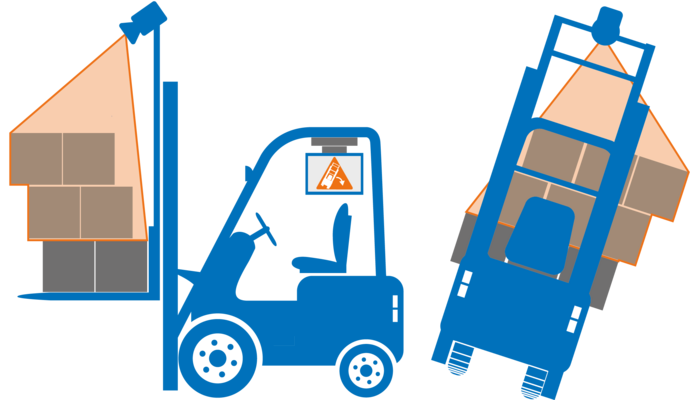On-board system to increase the occupational safety of forklift trucks through the multidimensional detection of load features.
The use of forklifts is part of everyday work in many German companies. These feature a high degree of flexibility combined with low investment costs. Accordingly, they are ideally suited to transport goods quickly and with little effort, which is why they will remain an important part of companies in the future. For this reason, safety and the operation forklifts are very important and the operators are regularly confronted with challenges. If the causes of severe and sometimes lethal accidents are considered, they are mostly due to driver misconduct and lack of operational organization. Although the number of accidents in general has been declining for years, this trend does not apply to accidents involving forklift trucks. If the particularly severe, lethal accidents are considered here, then these are by far attributable to the so-called "tipping accidents". In the context of the DGUV investigation, these types of accidents often result from cornering too fast and/or from improper loading of the forklift. Therefore, for a safe and efficient use of the forklift, the correct knowledge of the volume and weight of the forklift as well as the loading is required.
In addition to the safety aspects for the forklift, this information is also very important for the safety of adjacent processes, for example when loading a truck. This is essential data for the operator, as it allows him to estimate how many packages the forklift can be safely operated with on the one side and how a truck can be evenly loaded on the other. In the case of trucks, incorrect loading is also associated with avoidable disadvantages, e.g. higher one-sided wear and poorer driving characteristics, which in turn lead to higher risks in terms of driving accidents. For this reason, accurate determination of volume and weight is crucial for a risk-free and efficient work process.
However, determining these parameters is not only useful for the safety aspects, but also when considering the other processes in which the forklift is involved. Throughout the supply chain, the volume weight of the load is also of great importance. Optimal utilization of cargo space, correct invoicing of forwarding services, identification of the cargo, detection of damage and even compliance with safety standards when loading trucks or sea containers all go hand in hand with this.
The aim is to develop a valid on-board system that uses multidimensional recognition of load features to improve the occupational safety of forklift trucks and enable efficient measurement of freight. The development is based on the fact that there is no functional and reliable automated system available worldwide so far.
What is fundamentally unique is the design as an intelligent on-board system. This means that the new system, including sensors and computing units, can be integrated directly into the forklift truck, thus enabling the cargo to be measured and weighed by the forklift. This eliminates the need for manual or stationary work in the future, as the processes of weighing, measuring and identification are integrated and automated directly into the transport process. With the sensor data as well as a connection to a WMS, the transported goods can be precisely determined.
Existing devices and processes can only be transferred to the new, fully automated system to a limited extent due to the fundamentally different design of the existing systems. Instead, new devices and procedures must be developed. Not only the hardware, but also the software on which the system is based plays a central role. This must be able to determine the volume as well as the weight and mass distribution within a load carrier with the utmost precision. This makes processes much more efficient and minimizes overall risks.
With the help of a modular design, repairs can be performed easily and quickly. By combining the sensor information on the load distribution on the fork and the 3D point cloud from depth cameras, important information can also be determined for the subsequent transport in the truck and the load securing required there.
The first step is a requirement analysis regarding the framework conditions in which the system is located. These include environmental conditions, sensor characteristics and software requirements. These are documented in an overall architecture.
The corresponding hardware components are then installed for individual experiments and initial recordings are made. These are compared with the requirements and, if necessary, new sensor equipment is tested.
Based on the data from the sensors, parallel development of the software for the individual components is started. This is used to calculate the resulting information about the center of gravity on the forks and to describe the point clouds for the geometry of the load by volumetric means.
These individual components are continuously developed under laboratory conditions until the desired requirements are met.
Afterwards, the software is extended to combine the two information on load center and volume to identify complex information, such as compliance with the load diagram or unfavorable load distribution on the pallet.
In the final step, the resulting overall system is tested under realistic conditions and further optimized.
The ZIM project KK5178905FM1 is funded by the Federal Ministry for Economic Affairs and Climate Action (BMWK) via the AiF as part of the Central Innovation Program for SMEs (ZIM) on the basis of a decision of the German Bundestag.
